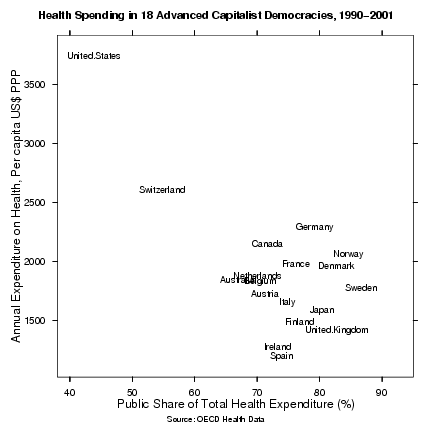Public and Private Health Care
Brayden King notes that the Wall Street Journal is concerned about ever-rising health care costs in the United States. I’ve been looking at data on national health systems for a paper I’m trying to write. It turns out that there’s a lot less theoretical work done on comparative health systems than you might think, certainly in comparison to the huge literature on welfare state regimes. Here’s a figure showing the relationship between the “Publicness” of the health system and the amount spent on health care per person per year. Data points are each country’s mean score on these measures for the years 1990 to 2001.  You can also get a nicer PDF version of this figure. As you can see, health care in other advanced capitalist democracies is typically twice as public and half as expensive as the United States.
You can also get a nicer PDF version of this figure. As you can see, health care in other advanced capitalist democracies is typically twice as public and half as expensive as the United States.
Now, this picture doesn’t resolve a whole bunch of arguments about the relative efficiency of public vs private care or the right kind of health system to have. (Brian discussed some of these issues last year. There’s not much evidence that the quality of care in the U.S. is twice as good as everywhere else.) Things are also complicated—or made worse—by the fact that, despite not having a national health system, U.S. public expenditure on health in the 1990s was higher in GDP terms than in Ireland, Switzerland, Spain, Austria, Japan, Australia and Britain. But a picture like this makes it easy to see that mainstream debate about health care in the U.S. happens inside a self-contained bubble, and that one of its main conservative tropes—the inevitable expense of some kind of universal health care system—is wholly divorced from the data.